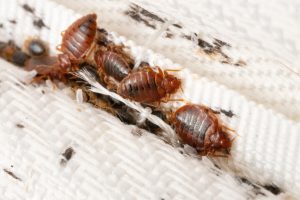Bed bugs are an increasingly common problem in the home and workplace. The warmth from a host’s body provides bed bugs with ideal breeding grounds, making them difficult to eliminate. As a homeowner, business owner or parent, you want to keep your home, co-workers and family safe from these unwelcome, gross visitors. It’s important to recognize the signs of bed bugs and what to do if they’re spotted.
What do Bed Bugs Look Like?
Bed bugs aren’t big, in fact, the larger ones only grow to about a quarter of an inch in length, but they’re normally smaller. Their oval-shaped, reddish-brown bodies are flat but will grow into a balloon shape after feeding. Larvae are light yellow in color and are difficult to see. Bed bugs often produce a sweet or musty smell used to communicate with each other.
How to Spot Bed Bugs
Bed bugs like to hide near the seams of mattresses and soft furniture, along piping, near tags, box springs, curtains, between cushions and sometimes even in the cracks of a bed frame or in furniture joints. In extreme cases, they can even be spotted around appliances and pictures.
Although bites while sleeping could be a sign of bed bugs, bites can also be caused by a number of insects or pests. However, in addition to bites, other signs of bed bugs include:
- Live bugs
- Red or rusty stains on the mattress, sheets or furniture, which are caused by crushed bed bugs.
- Dark spots that seep into the fabric, which is a sign of bed bug feces.
- Light-colored piles that are associated with the skin bed bugs shed as they progress through their lifecycle.
Bed Bug Lifecycle and Feeding
It takes a bed bug four to five weeks to hatch and turn into an egg-laying adult. Once they reach adulthood, they can live 6 -12 months, and females will lay 200-500 eggs in a lifetime.
Bed bugs typically feed every three to seven days, and usually at night. The feeding process takes anywhere from 5 – 12 minutes, and while humans are the preferred host, other mammals can be bitten by bed bugs too, including birds and pets. If no hosts are available, bed bugs can live a month up to a year without feeding.
Damage Caused by Bed Bugs
Depending on the person, a bed bug’s bite can cause an allergic reaction ranging from a small bite mark, rash or skin infection. It’s not uncommon for people living with bed bugs to suffer from anxiety and insomnia.
Soft furniture damaged from bed bug stains will likely need to be permanently removed from the home or office.
How to Control and Get Rid of Bed Bugs
Bed bugs are difficult to exterminate because they can survive temperatures up to 113 degrees and as low as 45 degrees. The best way to protect against bed bugs is to follow some simple tips:
- Add protective covers to mattresses and box springs. These prevent hiding spots and the bugs from making it onto the mattress, causing permanent damage.
- Use light colors on bedding. It’s easier to find signs of bed bugs on light colors.
- Reduce clutter around furniture and bedding. Keep areas clean and picked up, giving bugs fewer places to hide.
- Vacuum often.
- If using a shared laundry facility, use plastic bags to transport laundry directly into the washer and directly out of the dryer. Fold the laundry at home, away from public areas.
Depending on the scale of the infestation, bed bug treatments can take weeks to months to fully eliminate. The pest technicians at United Pest & Turf Control are trained, licensed and certified to properly identify bed bugs and apply treatments to control and exterminate the problem. It’s important to remember that it will likely take multiple treatments to become free from bed bugs. Contact us today for a free estimate.
Bed Bugs in North Alabama and Southern Tennessee
Serving North Central Alabama and South Central Tennessee
Limestone County
Ardmore
Home » Bed Bugs


